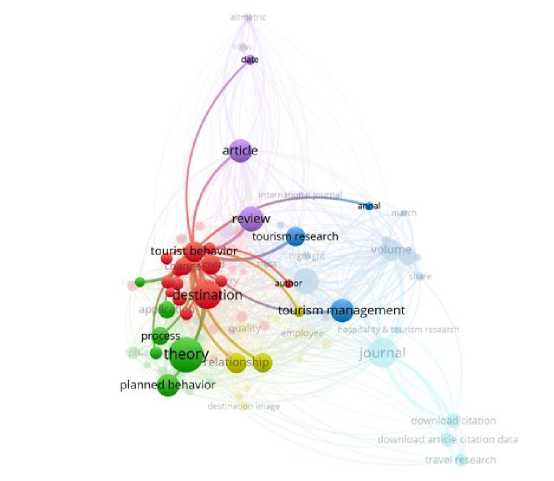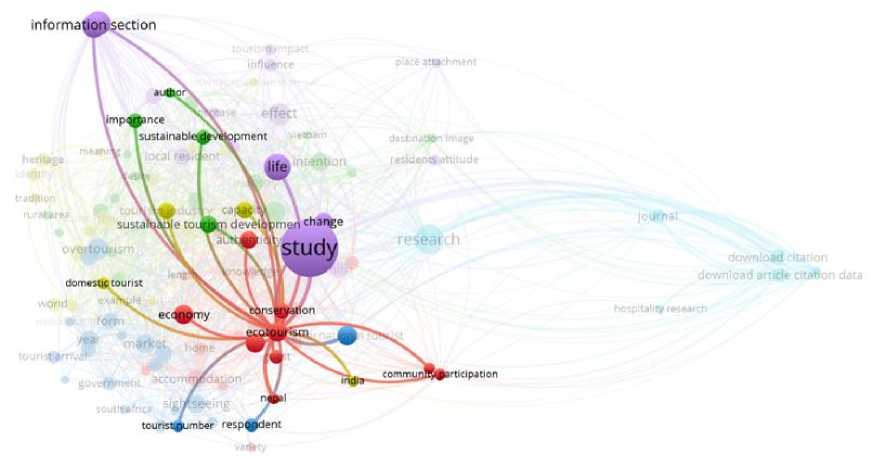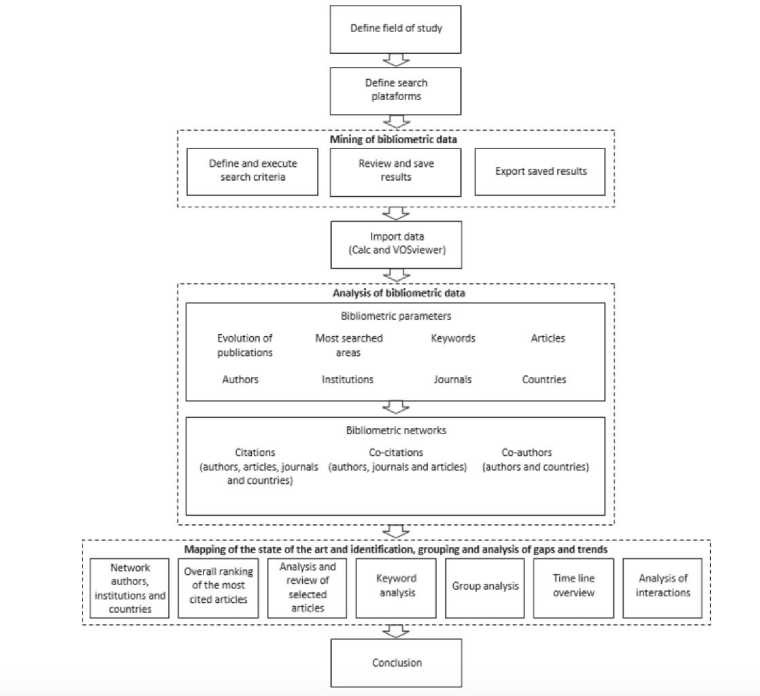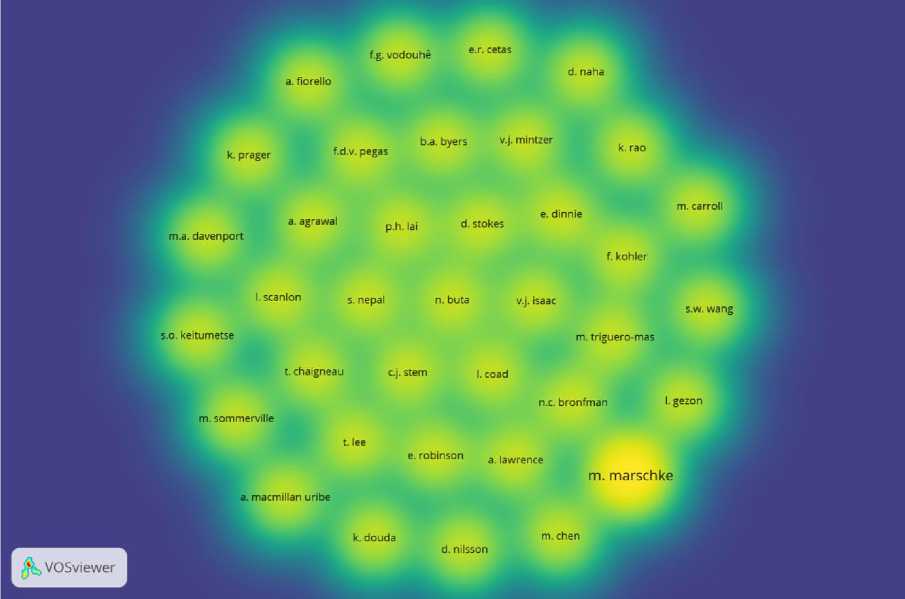Bibiliometric Mapping of Local Communities’ Environmental Conservation Behaviour
on
E-Journal of Tourism Vol.10. No.2. (2023): 241-250
Bibiliometric Mapping of Local Communities’ Environmental Conservation Behaviour
Supina*, Hari Iskandar
Bunda Mulia University
*Corresponding Author: supina@bundamulia.ac.id
DOI: https://doi.org/10.24922/eot.v10i2.100600
Article Info
Submitted:
May 1st 2023
Accepted:
September 20th 2023
Published:
September 30th 2023
Abstract
Before new trends emerge after the COVID pandemic is over, this paper aims to examine the development of recent research trends in the theories and methods applied to studies of local communities' behaviours towards environmental protection in the years 2018–2021. This paper presents a review of more than one thousand local communities' environmental conservation behaviours that was published between 2018 and 2021. The purpose of this research is to achieve its objective. Following that, content analysis was performed on the articles that were pertinent. In order to clarify, categorize, and interpret the current research on rural tourism definitions and applications, a classification scheme and an extensive literature review have been presented in this article. Both of these elements are presented in this paper. A total of 38 academic papers from 25 different journals published between the years 2018 and 2021 are included in this review's classification scheme. These papers are organized according to their use of one of five primary keywords: local, community, environmental, conservation, or behaviour. The fact that the articles under consideration in this research were only found in the Scopus database represents a potential limitation of the bibliometric mapping. This research contributes to the existing body of knowledge by conducting a bibliometric review of studies that have already investigated locals' perspectives on tourism, and this review adds to the tourism literature by analyzing the growing trend of looking at how different communities' actions affect environmental protection. Future research on these trends can be guided by identifying where the gaps in knowledge currently exist.
Keywords: bibliometric; publications; review; local communities; environmental conservation behaviour.
INTRODUCTION
Background
Because of its wide-ranging direct and indirect effects on economies, tourism is currently one of the most studied topics in economics literature (Shahbaz et al.,
2021; Paramati et al., 2017; Lee and Chang, 2008). Directly, this is a visualisation of a network containing one thousand studies on tourism that have been published in the last three years using the keyword tourism.

Figure 1. Network visualization on 1000 tourism studies in 2018-2021 with tourism as keyword
It can be seen that published research is quite inclined towards destination and behavior. There are lots type of tourism destination, and one that supports sustainability is rural tourism destination.
Specifically, the search for keywords: tourist, local people, local community, host, and tourism network visualization, here is the following results:

Figure 2. Network visualization on 1000 tourism studies in 2018-2021 with tourist, local people, local community, host, and tourism as keywords
The foregoing findings show that publishing research examples in support of responsible tourism is widely praticed, up
to 2021 alone there were more than 1.000 academic articles of tourism and environment. Increased focus on sustainable
tourism in the academic and business communities is a response to growing concerns about overtourism, environmental degradation, and the provision of unimaginative tourism products and temporary, inadequate services (Ming, et al., 2018). As a result, study on the advancement of contemporary research on environmental behavior in rural tourism locations will be relevant. And due to tourism involves a variety of stakeholders, including host communities, tourists, government, NGOs, Community Colleges, Universities, and the tourism industry (Weaver & Weaver, 2014), this study will concentrate on one of the most directly involved, namely the host communities. To further explore the connection between local community behaviour and environmental conservation, the article will also discuss previous research and literature on the topic.
Sustainability
According to Nguyen and Wells (2017), sustainability can be defined as a concept of development that meets the needs of the present without jeopardising the ability of future generations to meet their own needs. Sustainable tourism should maintain a consistent level of tourist satisfaction and provide a meaningful experience for visitors. This can be accomplished by increasing visitors' awareness of issues related to sustainability and encouraging them to participate in sustainable tourism efforts, particularly in the tourism industry. Any tourism development project that is not sustainable, that is, if it does not maintain fairness across all of its dimensions (social, economic, and environmental), should not be planned (Lopez-Sanz et al., 2021). (Lopez-Sanz et al., 2021). As envisioned by Sustainable Development Goal 17 (SDG17), which is titled "Partnership for the Goals," it is only possible to achieve sustainability in the tourism industry through collaboration, partnerships, and cooperative efforts (Mabibibi et al. 2021). Responsible tourism is concerned with the
effects of tourism on people, the environment, and communities. Its primary goal is to improve the living conditions of those who work in the tourism industry while also protecting local communities from harm (Mabibibi et al., 2021). In order to understand what constitutes sustainable tourism in rural areas, it is necessary to involve local communities as stakeholders. This is because the exhaustion of natural resources can threaten the availability of other resources vital to the survival of local communities (Chu & Karr, 2017). For tourism sustainability, the major goal is to develop creative tourism in rural areas through tourism activities in which tourists can develop their creative potential through active participation (Muhamad & Budiani. 2022). In many rural tourism destinations, sustainability remains fragile and must be strengthened through a more effective socioeconomic model (Pickel-Cheva-lier, et al., 2021).
Rural and Rural Tourism
Rural was defined by the OECD (1994) using a geographical criterion, separating the national territory into two levels: regional and local community, and there is no unambiguous definition of rural development in economic literature (Adamov et al., 2022). The rural population is defined by size, usage of land, economic and cultural activities and specific arrangements (Muresan & Ivan, 2016) and act as the most dynamic component of the rural areas and a potentially valuable resource for rural development, with a key role in formulating rural development policies (Muresan et al., 2016). The way people think about the rural areas has shifted dramatically. It used to rely exclusively on agriculture for survival, but it is now increasingly reliant on the service industry (Lopez-Sanz et al., 2021) such as tourism. Rural tourism is defined as a type of business that takes place in rural areas and has a variety of scales and character roles, according to (Fang, 2020) and is growing at
a greater rate than other forms of tourism (Martinez & Blanco, 2013;) as a result of the dramatic shifts that have taken place in people's perspectives regarding the rural environment. In the past, agriculture was its only source of income, but today, the service industry is becoming an increasingly significant contributor to its continued existence.
Host Communities
Priatmoko et al. (2021) asserts that local communities should be considered stakeholders in the comprehensive process of tourism development in village, which helps to reduce reliance on natural resources. In developing nations, community-based tourism emerges as a strategy for environmental conservation and community improvement, provided that the local group has significant control over tourism activities (Junaid et al., 2021; Gunawi-jaya & Pratiwi, 2016). Tourism will be perceived more positively by a more informed and involved local population (Lopes et al, 2019), as local communities' attachment to tourism development is favorably connected with local communities' impressions of tourism development (Wardana et al., 2020; Bajrami et al., 2020). (Wardana et al, 2020) stated community involvement includes: (1) identifying problems, (2) formulating objectives, (3) managing tourism businesses, (4) non-governmental organizations supporting rural tourism, (5) coordinating the administration of local resources and constructing essential infrastructure for rural tourism, and (6) having principles to ensure that development strategies do not deviate. Three primary reasons for communities’ opposition, according to Fang (2013), are peasants' tax burden, rural land expropriation, and urban relocation. Meanwhile, in rural regions, land issues such as expropriation and house demolition have steadily become the most important issues (Yu, 2005). Supporting it, Kusumawardhani (2022) carried out a comprehensive literature review with the purpose of describing the leadership style
in rural tourism that is required and has been widely adopted to assist and support the community in locating a successful leadership style in the process of developing rural tourism.
Studies on factors of local communities’ behaviors to environmental protection
A study found that there were significant differences between individuals with high and low degrees of connectedness to nature in terms of their pro-environmental behaviour, level of life satisfaction, beliefs about environmental behaviour, and knowledge of circular economies (Solano-Pinto et al, 2020) but mostly the environmental protection behavior occurs as a result of the positive impacts that tourism has on the local communities (Setiawan et al, 2020). One example of where locals were aware of the importance of keeping the environment clean and waste-free for environmental health and safe is in Langkawi Island, Malaysia (Shamshiry, et al., 2011) meanwhile community in Jatiluhur Reservoir, Indonesia still requires a great deal of empowerment (Anwar et al, 2021).
METHODS
A rigorous, open, and applicable method was utilised to compile the research on environmental behaviour in local communities that is contained in the hospitality and tourism literature. This was accomplished through the use of a bibliometric mapping. In order to integrate the hospitality and tourism literature on the environmental behaviour of local communities in a method that is rigorous, transparent, and reproducible, a bibliometric analysis has been conducted (Donthu et al., 2021). This strategy, which revolves around conducting keyword searches of the relevant literature in Scopus databases, is useful for identifying trends, identifying knowledge gaps, and developing theories (Becheikh et al., 2006). Only journals with published articles were searched, and a large number of keywords were used e-ISSN 2407-392X. p-ISSN 2541-0857
because previous publications showed a wide variety of terms for and approaches to studying the environmental behaviour of rural communities. The terms "local," "community," "environmental," "conservation," and "behaviour" were used to conduct a search of databases. The scope of the search included only works published between 2002 and 2021. Two hundred appropriate publications were located during the
search for the mapping; however, only 38 articles met the screening criteria for indepth analysis based on study location, perspective of analysis, methodology, depth of analysis, and specific themes addressed. Thorpe et al. (2005) note that using such a wide variety of criteria makes it possible to explicitly and rigorously classify the content of the papers into various thematic groups.

Figure 3. Methodological steps for outlining the current research landscape and pointing out future directions in the field (Source: Jose et al., 2019)
RESULTS AND DISCUSSION
Results and discussions of outlining the current research landscape and pointing out future directions in the field

Figure 4. Density Visualization of authors, countries, institutions, articles, and keywords
Provides an analytical description of the publications that have been reviewed based on the following criteria: principal
focus is on on local communities’ environmental behavior; the study's location is in a rural area; and the analysis' perspective.
Publication Trend per Year
6
5
4
3
2
1

0
2000 2002 2004 2006 2008 2010 2012 2014 2016 2018
2020
Figure 5. Publication Trend per Year
Table 1. Articles' Availability in Various Publications Based on the Journal
|
Journal |
No of articles |
(%) |
|
Journal of Sustainable Tourism |
2 |
5,26 |
|
Human Ecology |
1 |
2,63 |
|
Mountain Research and Development |
2 |
5,26 |
|
Society and Natural Resources |
1 |
2,63 |
|
Appetite |
1 |
2,63 |
|
Journal of Hospitality Marketing and Management |
1 |
2,63 |
|
Forest Policy and Economics |
1 |
2,63 |
|
Tourism Management |
1 |
2,63 |
|
Development Southern Africa |
1 |
2,63 |
|
Environmental Conservation |
3 |
7,89 |
|
Landscape and Urban Planning |
1 |
2,63 |
|
Diversity and Distributions |
1 |
2,63 |
|
Natural Resources Forum |
1 |
2,63 |
|
Journal of Ecotourism |
1 |
2,63 |
|
Journal of Environmental Management |
2 |
5,26 |
|
Journal of Outdoor Recreation and Tourism |
1 |
2,63 |
|
Conservation Biology |
5 |
13,16 |
|
Philosophical Transactions of the Royal Society B: Biological Sciences |
1 |
2,63 |
|
Biological Conservation |
1 |
2,63 |
|
Sustainability (Switzerland) |
2 |
5,26 |
|
Anais da Academia Brasileira de Ciencias |
1 |
2,63 |
|
Environmental Management |
4 |
10,53 |
|
Biodiversity and Conservation |
1 |
2,63 |
|
Marine Policy |
1 |
2,63 |
|
PLoS ONE |
1 |
2,63 |
|
CONCLUSION In this study, literature related to local communities’ environmental conservation behaviour was bibliometrically reviewed, and after outlining the current research landscape, pointing out future directions in the field, and filtering the research location specifically to a rural tourism destination, 38 articles were processed as a result of the erratic flow of publications http://ojs.unud.ac.id/index.php/eot 2 |
throughout the years 2018–2021, from two hundred appropriate publications that were located during the search for the bibliometric mapping. The publication, which is based on its journal, is extremely diverse and is not concentrated on a single journal; furthermore, its distribution does not overlap. However, this review offers tourism researchers a glimpse into the nature and structure of studies that are currently being 7 e-ISSN 2407-392X. p-ISSN 2541-0857 |
conducted on locals' attitudes towards tourism. This study contributes to the body of knowledge by providing an overview of the current status of research on residents' attitudes towards tourism. This overview paves the way for future scholarly investigation by pointing in the right direction for further investigation. The distribution of publications that were found in earlier reviews of articles on the attitudes of locals towards tourism is yet another contribution that this review makes. The application of geographical context could be considered a suggestion for future research in order to produce more comprehensive reviews.
REFERENCES
Adamov, T., Iancu, T., Peț, E., Popescu, G., Șmuleac, L., Feher, A., & Ciolac, R. (2022). Rural tourism in Margin-imea Sibiului area—a possibility of capitalizing on local resources. Sustainability, 15(1), 241.
https://doi.org/10.3390/su15010241
Anwar, R. K., Hadia, M. S., Hendarma-wan, & Khadijah, U. (2021). Community Participation In Environmental Management At Jatiluhur Reservoir Tourism Site, Indonesia. Procedia Environmental Science, Engineering and Management, 8(2), 363-370. National Society of Environmental Science and Engineering .
Bajrami, D.D., Radosavac, A., Cim-baljević, M., Tretiakova, T. N., & Syromiatnikova, Y. A. (2020). Determinants of residents’ support for Sustainable Tourism Development: Implications for Rural Communities. Sustainability, 12(22), 9438.
https://doi.org/10.3390/su12229438
Becheikh, N., Landry, R., & Amara, N. (2006). Lessons from innovation empirical studies in the manufacturing sector: A systematic review of the literature from 1993–2003. Technovation, 26(5-6), 644–664.
https://doi.org/10.1016/j.technova-tion.2005.06.016
Chu, E. W., & Karr, J. R. (2017). Environmental impact: Concept, Consequences, measurement. Reference Module in Life Sciences. https://doi.org/10.1016/b978-0-12-809633-8.02380-3
Donthu, N., Kumar, S., Mukherjee, D., Pandey, N., & Lim, W. M. (2021). How to conduct a bibliometric analysis: An overview and guidelines. Journal of Business Research, 133, 285–296.
https://doi.org/10.1016/j.jbusres.20 21.04.070
Fang, Q. (2013). Chinese complaint system: Natural resistance. Abingdon, England: Routledge.
Fang, W. T. (2020). Rural Tourism. Tourism in Emerging Economies. Singapore: Springer.
Gunawijaya, J., & Pratiwi, A. (2016). Destination development for rural tourism area in Wanayasa, Puwakarta, West Java, Indonesia. E-Journal of Tourism.
https://doi.org/10.24922/eot.v3i2.24 003
José de Oliveira, O., Francisco da Silva, F., Juliani, F., César Ferreira Motta Barbosa, L., & Vieira Nunhes, T.
(2019). Bibliometric Method for Mapping the State-of-the-Art and Identifying Research Gaps and Trends in Literature: An Essential Instrument to Support the Development of Scientific Projects. Scien-tometrics Recent Ad
vances. doi:10.5772/intechopen.858 56
Junaid, I., Sigala, M., & Banchit, A.
(2021). Implementing communitybased tourism (CBT): Lessons learnt and implications by involving students in a CBT project in Laelae
Island, Indonesia. Journal of Hospitality, Leisure, Sport & Tourism Education, 29, 100295.
https://doi.org/10.1016/j.jhlste.2020 .100295
Kusumawardhani, Y. (2022). Systematic Literature Review and Future Agenda: Leadership Style and dimension in rural tourism settings. EJournal of Tourism, 157.
https://doi.org/10.24922/eot.v9i2.89 035
Lee, C.-C., & Chang, C.-P. (2008). Tourism Development and economic growth: A closer look at panels. Tourism Management, 29(1), 180– 192. https://doi.org/10.1016/j.tour-man.2007.02.013
Lopes, H. D., Remoaldo, P., & Ribeiro, V. (2019). Residents' perceptions of tourism activity in a rural NorthEastern Portuguese community: A cluster analysis. Bulletin of Geography. Socio-economic series, 46, 119135.
López-Sanz, J. M., Penelas-Leguía, A., Gutiérrez-Rodríguez, P., & Cuesta-Valiño, P. (2021). Sustainable development and consumer behavior in rural tourism—the importance of image and loyalty for host communities. Sustainability, 13(9), 4763. https://doi.org/10.3390/su13094763
Mabibibi, M. A., Dube, K., & Thwala, K. (2021). Successes and challenges in Sustainable Development Goals Localisation for host communities around Kruger National Park. Sustainability, 13(10), 5341.
https://doi.org/10.3390/su13105341
Martínez, V., & Blanco, R. (2013). Hacia una gestión sostenible de las Ac-tividades Turísticas en Los Espacios Rurales y naturales. Revista Inter-nacional De Organizaciones, (10), 131.
Muhamad, M., & Budiani, S. R. (2022). Rural Creative Tourism as a growth triangle on the slopes of Mount Sumbing, Magelang. E-Journal of Tourism, 47.
https://doi.org/10.24922/eot.v9i1.84 035
Muresan, I., Oroian, C., Harun, R., Arion, F., Porutiu, A., Chiciudean, G., Todea, A., & Lile, R. (2016). Local residents’ attitude toward sustainable rural tourism development. Sustainability, 8(1), 100.
https://doi.org/10.3390/su8010100
Nguyen, P. T., & Wells, S. (2017). Systemic indicators for rural communities in developing economies: Bringing the shared vision into being. Systemic Practice and Action Research, 31(2), 159–177.
https://doi.org/10.1007/s11213-017-9421-z
OECD. (1994). Creating Rural Indicators for Shaping Territorial Policies (Paris: OECD).
Paramati, S. R., Alam, M. S., & Chen, C.-F. (2016). The effects of tourism on economic growth and co2emissions: A comparison between developed and developing economies. Journal of Travel Research, 56(6), 712–724. https://doi.org/10.1177/0047287516 667848
Pickel-Chevalier, S., Bendesa, I. K., & Darma Putra, I. N. (2021). The integrated touristic villages: An Indonesian model of sustainable tourism? Island Tourism Sustainability and Resiliency, 262–286.
https://doi.org/10.4324/9781003280 521-14
Priatmoko, S., Kabil, M., Purwoko, Y., & Dávid, L. D. (2021). Rethinking Sustainable Community-based tourism: A Villager’s point of view and case study in Pampang Village, Indonesia. Sustainability, 13(6), 3245. e-ISSN 2407-392X. p-ISSN 2541-0857
Setiawan, B., Afiff, A. Z., & Heruwasto, I. (2020). Integrating the theory of planned behavior with norm activation in a pro-environmental context. Social Marketing Quarterly, 26(3), 244–258.
Shahbaz, M., Bashir, M. F., Bashir, M. A., & Shahzad, L. (2021). A bibliometric analysis and systematic literature review of Tourism-Environmental Degradation Nexus. Environmental Science and Pollution Research, 28(41), 58241–58257.
https://doi.org/10.1007/s11356-021-14798-2
Shamshiry, E., Nadi, B., Bin Mokhtar, M., Komoo, I., Saadiah Hashim, H., & Yahaya, N. (2011). Integrated Models for Solid Waste Management in Tourism Regions: Langkawi Island, Malaysia. Journal of Environmental and Public Health, (1–
5). doi:10.1155/2011/709549
Solano-Pinto, N., Garrido, D., Gértrudix-Barrio, F., & Fernández-Cézar, R. (2020). Is knowledge of circular economy, pro-environmental behavior, satisfaction with life, and beliefs a predictor of connectedness to nature in rural children and adolescents? A pilot study. Sustainability, 12(23), 9951.
Thorpe, R., Holt, R., Macpherson, A., & Pittaway, L. (2005). Using knowledge within small and medium-sized firms: A systematic review of the evidence. International Journal of Management Reviews, 7(4), 257–281.
https://doi.org/10.1111/j.1468-2370.2005.00116.x
Wardana, I. M., Sukaatmadja, I. P., Yasa, N. N., & Setini, M. (2020). Comparative and competitives advantages: Perspective of rural tourism (study on tourism in the Province of Bali Indonesia). GeoJournal of Tourism
and Geosites, 33(4), 1493–1500.
https://doi.org/10.30892/gtg.334spl 07-598
Weaver, D. B., & Lawton, L. (2014). Tourism management. Wiley.
Yu, J. (2005). Tudi wenti yi chengwei nongmin weiquan kangzheng de jiaodian (Land problemshave become the focal point of peasants’ rights struggles). Diaoyan shijie (World of survey and research) 18(3), 22–3.
http://ojs.unud.ac.id/index.php/eot
250
e-ISSN 2407-392X. p-ISSN 2541-0857
Discussion and feedback